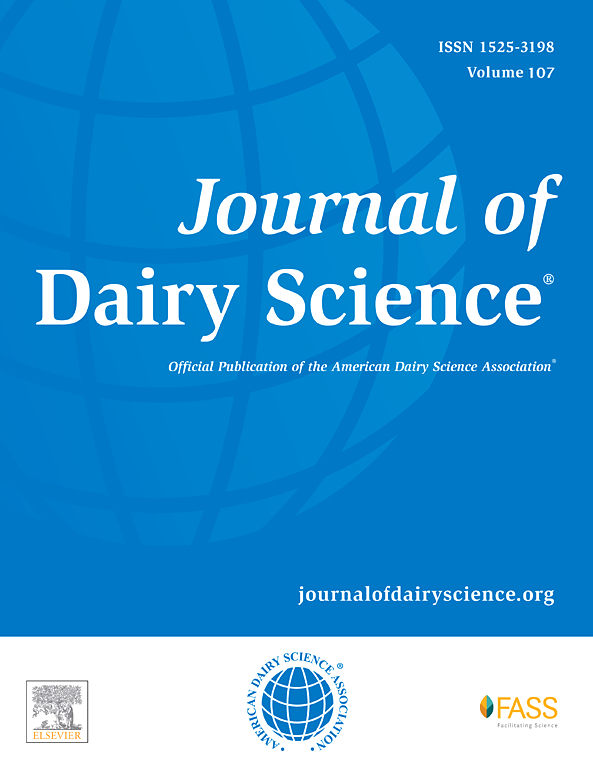Investigating the epidemiology of hyperketonemia in grazing dairy cows in early lactation: Incidence, prevalence, and time to resolution of hyperketonemia
IF 3.7
1区 农林科学
Q1 AGRICULTURE, DAIRY & ANIMAL SCIENCE
引用次数: 0
Abstract
Most cows experience a degree of negative energy balance due to an energy deficit during early lactation, which leads to the mobilization of body tissue to support milk production and results in the production of ketone bodies. Elevated ketones have been associated with an increased risk of clinical ketosis and reduced cow performance and health. The objectives of this study were to (1) characterize the incidence and prevalence of hyperketonemia (HYK) and severe HYK (Sev-HYK) in 3 seasonal calving herds of grazing dairy cows in early lactation, and (2) characterize the time to resolution of HYK based on the timing and degree of HYK. Grazing cows from 3 dairy farms were tested 15 times (mean ± SD; 14.9 ± 0.4 tests) for HYK between 1 and 35 DIM using a hand-held meter. Hyperketonemia was defined as blood BHB ≥1.2 to 2.9 mmol/L and Sev-HYK was defined as blood BHB ≥3.0 mmol/L. Associations between time to resolution of HYK and factors influencing this (farm, timing and magnitude of the first positive HYK test) were investigated by survival analysis using Cox regression. A total of 749 (76%) of 980 eligible cows were classified with HYK or Sev-HYK at least once within 35 DIM. Cumulative incidence of HYK was 64% within 14 DIM and varied across farm A (40%), farm B (76%), and farm C (74%). Cumulative incidence of Sev-HYK was 11% within 35 DIM and varied across farm A (12%), farm B (18%), and farm C (6%). Peak incidence of HYK occurred at 3 DIM, when 34% of cows had their first positive HYK test; however, peak HYK incidence and timing of peak incidence varied widely between the 3 herds (20% at 7 DIM on farm A, 38% at 4 DIM on farm B, and 58% at 3 DIM on farm C). Median time from the first positive HYK test (1.2 to 2.9 mmol/L) to a negative test (<1.2 mmol/L) was 3.3 d. In multivariable models, blood BHB concentration (≥1.2 to <2.0 mmol/L vs. 2.0 to 2.9 mmol/L) and timing (≤4 DIM vs. >4 DIM) of the first positive HYK test were associated with the time taken to resolve HYK (blood BHB <1.2 mmol/L) within 35 DIM. Cows with blood BHB 1.2 to <2.0 mmol/L at their first positive HYK test were 43% more likely to resolve HYK than cows that tested 2.0 to 2.9 mmol/L at their first positive test within 35 DIM. Further, cows that first tested positive after 4 DIM were 62% more likely to resolve HYK than cows that first tested positive within the first 4 DIM. Our results indicate substantial variation in the incidence and prevalence of HYK across 3 case study herds in seasonal calving, pasture-based systems. The time of HYK onset relative to calving and BHB concentration at the first HYK-positive test can influence the time taken to resolve HYK.
调查放牧奶牛泌乳早期高酮血症流行病学的案例研究:高酮血症的发病率、流行率和解决时间。
大多数奶牛都会经历一定程度的负能量平衡,这是由于哺乳早期能量不足导致身体组织动员以支持产奶量,从而导致酮体的产生。酮类升高与临床酮症风险增加、奶牛生产性能和健康状况下降有关。本研究的目的是:1)表征3个季节放牧奶牛产犊群泌乳早期高酮血症(HYK)和重度HYK (Sev-HYK)的发病率和患病率;2)根据HYK发生的时间和程度表征HYK的解决时间。对3个奶牛场的放牧奶牛进行15次检测(mean±SD;14.9±0.4测试),HYK在1和35 DIM之间使用手持式仪表。高酮血症定义为血液BHB≥1.2 ~ 2.9 mmol/L, Sev-HYK定义为血液BHB≥3.0 mmol/L。采用Cox回归生存分析,研究HYK消退时间与影响因素(农场、首次HYK试验阳性的时间和程度)之间的关系。980头符合条件的奶牛中,有749头(76%)在35个DIM内至少被分类为HYK或Sev-HYK。14个DIM内的累积发病率为71%,在A场(40%)、B场(76%)和C场(74%)之间存在差异。Sev-HYK在35个DIM内的累积发病率为11%,在农场A(12%)、农场B(18%)和农场C(6%)之间有所不同。HYK发病高峰出现在3 DIM, 34%的奶牛首次出现HYK阳性;然而,HYK的高峰发病率和高峰发病时间在3个畜群之间差异很大(A农场7 DIM时为20%,B农场4 DIM时为38%;3昏暗的农场和58% C)。平均时间从第一积极HYK测试(1.2到2.9更易/ L)的负面测试(4昏暗)第一个积极HYK测试与时间有关解决HYK(血液BHB < 1.2更易/ L) 35暗淡。牛血BHB 1.2 < 2.0 L更易在他们第一次正面HYK测试比牛更容易解决HYK 43%测试2.0 - 2.9更易与L在他们第一次在35暗淡。进一步积极测试,在4次DIM后首次检测呈阳性的奶牛比在前4次DIM内首次检测呈阳性的奶牛解决HYK的可能性高62%。我们的研究结果表明,在季节性产犊、牧场系统的3个案例研究牛群中,HYK的发病率和流行率存在很大差异。相对于产犊的HYK发病时间和首次HYK阳性试验时的BHB浓度可以影响HYK溶解所需的时间。
本文章由计算机程序翻译,如有差异,请以英文原文为准。
求助全文
约1分钟内获得全文
求助全文
来源期刊

Journal of Dairy Science
农林科学-奶制品与动物科学
CiteScore
7.90
自引率
17.10%
发文量
784
审稿时长
4.2 months
期刊介绍:
The official journal of the American Dairy Science Association®, Journal of Dairy Science® (JDS) is the leading peer-reviewed general dairy research journal in the world. JDS readers represent education, industry, and government agencies in more than 70 countries with interests in biochemistry, breeding, economics, engineering, environment, food science, genetics, microbiology, nutrition, pathology, physiology, processing, public health, quality assurance, and sanitation.
 求助内容:
求助内容: 应助结果提醒方式:
应助结果提醒方式:


